
A standard high school track typically measures 400 meters in length for one lap around the innermost lane. The track is usually oval-shaped and features eight lanes, each about 1.22 meters (4 feet) wide. The infield, commonly used for field events and sports like football or soccer, offers additional flexibility in space usage. Knowing these dimensions helps athletes, coaches, and facility managers plan workouts, races, and events accurately.
Length Of 400 Meters
The standard high school track comprises a length of 400 meters, making it a single loop that athletes must complete for various races. This distance is equivalent to approximately 437.4 yards, providing an ideal setting for sprinting and middle-distance competitions. Track events typically include the 100-meter, 200-meter, 400-meter, 800-meter, and 1600-meter races, each benefiting from this standardized layout. In most high schools, the surface of the track is constructed with synthetic materials, ensuring optimal performance and safety for student-athletes.
Oval Shape
High school track facilities typically feature an oval shape, designed to optimize performance and safety for athletes. The standard 400-meter track consists of two straightaways and two curved sections, allowing for a balanced distribution of speed and endurance testing. Many tracks are constructed with synthetic surfaces, which enhance grip and reduce injury risks, offering an ideal setting for both sprinting and distance events. Your local high school may also incorporate additional features such as markings for various race distances, typically including 100m, 200m, and 400m, ensuring a comprehensive training environment.
Eight Lanes
High school track facilities typically emphasize an eight-lane design, providing optimal conditions for competitive racing. This configuration allows for simultaneous events, accommodating up to eight athletes per race, which maximizes participation and spectator engagement. Each lane is usually designed to be 1.22 meters wide, ensuring fairness and safety for competitors. The overall track surface often consists of polyurethane or similar materials, enhancing performance through improved traction and reduced injury risk.
Lane Width Of 1.22 Meters
In high school track events, the standard lane width measures 1.22 meters, ensuring ample space for athletes to compete safely and effectively. This specific measurement is crucial for maintaining fair competition, allowing runners to have equal footing throughout races, especially in events such as the 100 meters and the 400 meters. The track layout typically features eight to nine lanes, enabling a larger number of participants in various competitions. Your understanding of these dimensions is essential for proper track preparation and athlete performance evaluation.
Inner And Outer Curves
High school track design typically features an oval shape, composed of two straight segments and two curved sections: the inner and outer curves. The standard distance for a full lap is 400 meters, with the inner curve being approximately 36.8 meters in radius, while the outer curve extends to about 40.5 meters. These measurements ensure that athletes experience equal competition, as the staggered start positions on the straights compensate for the varying distances incurred by the differing radius of the curves. Understanding these dynamics enhances your strategy during races, especially in events like the 200m and 400m sprints.
Straights And Curves Ratio
In high school track design, the standard oval layout typically measures 400 meters in circumference, featuring straight sections that are 84.39 meters long and two curves, each measuring 115.61 meters. This ratio ensures athletes can achieve optimal speed while navigating the track, as the straightaways allow for acceleration, while the curves test stamina and technique. The banking of the curves, often set at around 4 to 6 degrees, enhances centrifugal force, aiding runners in maintaining velocity. Understanding this design can help you appreciate the strategic elements of track events and improve your performance.
Start And Finish Line Placement
High school track standards emphasize precise placement of start and finish lines to ensure fair competition and accurate timing. Typically, the finish line is positioned 100 meters from the starting line for sprint events, with a staggered start for races exceeding 200 meters to account for lane distance. The measurements adhere to a standard width of 1.22 meters for lanes, allowing athletes to maintain optimal performance without interference. Ensuring that these lines are correctly marked contributes significantly to the integrity and professionalism of track and field events.
Curbing On The Inner Edge
High school track standards emphasize the importance of proper lane etiquette, particularly when curbing on the inner edge of the track. Runners should be aware that this inner lane, typically marked as Lane 1, is often reserved for faster athletes, ensuring a smooth flow during races. The inner edge of the track features a tighter radius, meaning the distance covered in this lane is slightly shorter than in outer lanes, necessitating strategic pacing. When transitioning onto this inner edge during competition, maintaining speed while adhering to lane guidelines can significantly impact your overall time and performance.
Markings For Distances/Events
High school track and field facilities typically feature standard markings to indicate specific distances for various events, such as 100m, 200m, and 400m races. The track circumference is generally 400 meters measured along the innermost lane, ensuring uniformity across competitions. Outdoor tracks often use bright colors--typically white or yellow--for lane lines and distance markers, ensuring visibility during events. In addition to event-specific lines, the long jump and triple jump areas include clearly marked takeoff boards, crucial for accurate measurements and fair competition.
Material Surface (E.G., Synthetic, Rubber)
High school track surfaces typically prioritize synthetic materials, with rubber being a popular choice for its durability and shock-absorption properties. These surfaces contribute to athlete performance, providing consistent traction and stability, essential for sprinting and jumping events. Tracks often measure 400 meters in circumference, accommodating various lanes for competitive racing under standard regulations. By choosing an appropriate surface, schools can enhance safety and improve overall athletic outcomes, allowing students to achieve personal bests with confidence.
